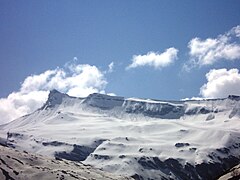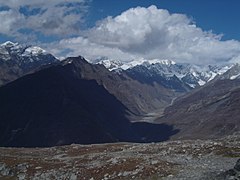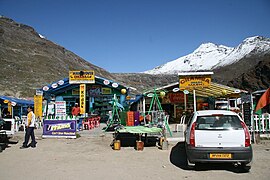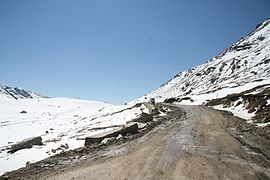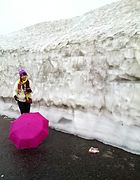Rohtang Pass: Difference between revisions
William Raw (talk | contribs) Tags: Reverted Mobile edit Mobile web edit |
Undid revision 1004595809 by William Raw (talk) |
||
| Line 47: | Line 47: | ||
[[File:View of Rothang pass.jpg|thumb|View of Rothang Pass]] |
[[File:View of Rothang pass.jpg|thumb|View of Rothang Pass]] |
||
== |
==Road tunnel under the Pass== |
||
{{Main|Atal Tunnel}} |
{{Main|Atal Tunnel}} |
||
As the pass gets blocked by snow and the road over the pass closes from November to May rendering [[Lahaul]] and [[Spiti]] districts north of the pass inaccessible, a need was felt to build a tunnel under the pass. The road tunnel called ''Atal Tunnel'' has been excavated and became operational on 3rd October 2020 after formal inauguration by Prime Minister Narendra Modi. It obviates the need to travel over the Rohtang Pass. While it takes 4 to 6 hours to ascend, negotiate and descend the Rohtang Pass, travel through the Rohtang Tunnel takes only about 30 minutes. |
As the pass gets blocked by snow and the road over the pass closes from November to May rendering [[Lahaul]] and [[Spiti]] districts north of the pass inaccessible, a need was felt to build a tunnel under the pass. The road tunnel called ''Atal Tunnel'' has been excavated and became operational on 3rd October 2020 after formal inauguration by Prime Minister Narendra Modi. It obviates the need to travel over the Rohtang Pass. While it takes 4 to 6 hours to ascend, negotiate and descend the Rohtang Pass, travel through the Rohtang Tunnel takes only about 30 minutes. |
||
Revision as of 21:03, 5 February 2021
| Rohtang Pass | |
|---|---|
 A view from Rohtang Pass | |
| Elevation | 3,978 m (13,051 ft) |
| Traversed by | Leh-Manali Highway |
| Location | India |
| Range | Pir Panjal, Himalayas |
| Coordinates | 32°22′17″N 77°14′47″E / 32.37139°N 77.24639°E |
Rohtang Pass (Rohtang , lit: རོ་ (Ro)- suvanch, ཐང་། (thang)- plain/field [1]) is named as such due to people working in bad weather trying to cross the pass) . [2][3][4][5] It is a high mountain pass (elevation 3,980 m (13,058 ft)) on the eastern end of the Pir Panjal Range of the Himalayas around 51 km (32 mi) from Manali. It connects the Kullu Valley with the Lahaul and Spiti Valleys of Himachal Pradesh, India.
Geography
The pass provides a natural divide between the Kullu Valley with a primarily Hindu culture (in the south), and the arid high-altitude Lahaul and Spiti valleys with a Buddhist culture (in the north). The pass lies on the watershed between the Chenab and Beas basins. On the southern side of this pass, the Beas River emerges from underground and flows southward[6] and on its northern side, the Chandra River (flows from the eastern Himalayas), a source stream of the river Chenab, flows westward.
Overview
The pass is open from May to November. It is not particularly high or difficult to cross on foot by Himalayan standards, but it has a well-deserved reputation for being dangerous because of unpredictable snowstorms and blizzards.[7]
This pass is an ancient trade route between the people on either side of Pir Panjal. The local name for this pass is a generic name of pass.[citation needed] There are many other passes in Lahaul and Spiti which have specific names (Kunzam La, Baralacha La, etc.). This is suggestive of the fact that this must have been the oldest and most frequented pass in the region, or the fact that it is the main pass leading from one cultural region to another, quite different one, to the north. The name Rohtang comes from Persian/ Farsi words Ruh+ Tang which means pile of dead bodies.[citation needed]
The former National Highway 21 (NH 21, now numbered NH 3), the road through the Kullu Valley, terminates at Manali. The road northwards over the Rohtang Pass to Keylong in Lahaul and Spiti district and on to Leh in Ladakh is not a national highway. Nonetheless, the Leh-Manali Highway has become very busy during the summer months as an alternate military route since the Kargil Conflict in 1999. Traffic jams are common as military vehicles, trucks, and goods carriers try to navigate the tight roads and rough terrain, compounded by snow and ice at certain points and the large number of tourist vehicles.

 Waterfall on the Beas River, Marhi (Elev. 3,360 m (11,020 ft)
Waterfall on the Beas River, Marhi (Elev. 3,360 m (11,020 ft)Several episodes of the History Channel's Ice Road Truckers series spinoff IRT Deadliest Roads dealt with truckers crossing the Rohtang Pass to deliver supplies.[8][9] With increase in Traffic at Rohtang Valley, environmentalists fear its impact on the fragile mountain ecology. A rise in average temperature, and the consequent melting of glaciers, are also issues of severe concern.[10]
Climate
The Rohtang pass has polar climate köppen (ET) and snow falls sometimes even in summer.[Citation needed]
Latest News
Sometimes travelling to Rohtang Pass is difficult. Therefore, the government is stressing on setting up a ropeway between Kothi village which is in Manali and Rohtang Pass. The NGT (National Green Tribunal) has asked the state government of Himachal Pradesh to complete all the formalities to start a ropeway. With the coming of a ropeway, we can reduce carbon emission from vehicles. Heavy snowfall blocks the road in winter and a ropeway will be very useful.[11]

Road tunnel under the Pass
As the pass gets blocked by snow and the road over the pass closes from November to May rendering Lahaul and Spiti districts north of the pass inaccessible, a need was felt to build a tunnel under the pass. The road tunnel called Atal Tunnel has been excavated and became operational on 3rd October 2020 after formal inauguration by Prime Minister Narendra Modi. It obviates the need to travel over the Rohtang Pass. While it takes 4 to 6 hours to ascend, negotiate and descend the Rohtang Pass, travel through the Rohtang Tunnel takes only about 30 minutes.
Gallery
-
Winter sports
-
A panoramic view of distant Himalayan peaks from Rohtang Pass, May 2009
-
Mountains near Rohtang Pass
-
Leh-Manali Highway as seen from near the Rohtang Pass
-
Rohtang Pass during winter on Leh-Manali Highway
-
Tourist Vehicles at Rohtang Pass, May 2009
-
A view of Dhabas (road-side eateries) at Marhi and Leh-Manali Highway on the way to Rohtang Pass, May 2009
-
View from top of Rohtang
-
Traffic jam descending from Rohtang, 2004
-
Tourist rest stop at the south approach to Rohtang Pass, 2007
-
Steep switchback descent from Rohtang Pass summit towards Manali, 2007
-
Wine shop on the way to the pass
-
North approach to Rohtang Pass Summit, 2007
-
Summit of Rohtang Pass, altitude 13,000 feet above Sea Level, 2007
-
Summit of Rohtang Pass 13,000 ft above Sea Level, October 2007
-
Near Rothang Pass and the Lady, July 2015
References
- ^ Polgreen, Lydia "India Digs Under Top of the World to Match Rival". New York Times. Accessed 31 July 2010.
- ^ "Panoramio - Photo of Rohtang Pass (3978 m)". panoramio.com. Retrieved 3 September 2015.
- ^ "Rohtang Pass - Himalayan Fantasy". himalayan-fantasy.com. Retrieved 3 September 2015.
- ^ "Image: Rohtang-pass Himalayas.jpg, (450 × 338 px)". mountainhighs.com. Retrieved 3 September 2015.
- ^ "Image: news_a3f1d190-1ebf-208f-9c4f-4dfee1789304.jpg, (350 × 525 px)". taxivala.com. Retrieved 3 September 2015.
- ^ himachalpradesh.us. "Beas River in Himachal Pradesh". Archived from the original on 14 April 2009. Retrieved 24 June 2009.
- ^ Janet Rizvi (1 June 1998). Ladakh: Crossroads of High Asia. Oxford University Press. pp. 9–10. ISBN 978-0-19-564546-0.
- ^ "Crumbling Roads". IRT Deadliest Roads. Season 1. Episode 5. 31 October 2010. History Channel. Retrieved 2 November 2010.
- ^ History Channel USA "http://www.history.com/shows/irt-deadliest-roads" Accessed on 28 February 2011
- ^ "Rohtang Pass fears ensuing Disaster due to Traffic Surge". Retrieved 1 October 2013.
- ^ "Latest News". Retrieved 19 August 2017.



